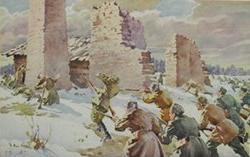Battle of Paju
| Battle of Paju | |||||||
|---|---|---|---|---|---|---|---|
| Part of Estonian War of Independence | |||||||
 Battle of Paju. Painting by Maximilian Maksolly |
|||||||
|
|||||||
| Belligerents | |||||||
|
|
|
||||||
| Commanders and leaders | |||||||
|
Hans Kalm Julius Kuperjanov † |
Emīls Vītols | ||||||
| Strength | |||||||
| 683 men | 1,200 men | ||||||
| Casualties and losses | |||||||
| 156 | about 300 | ||||||
The Battle of Paju (Estonian: Paju lahing) was fought in Paju, near Valga, Estonia, on 31 January 1919 during the Estonian War of Independence. After heavy fighting, the Tartu-Valga group of the Estonian Army pushed the Red Latvian Riflemen out of the Paju Manor. It was the fiercest battle in the early period of war. Estonian commander Julius Kuperjanov fell in the fighting.
In early January 1919 Estonian forces had started a full-scale counterattack against invading Soviets. Their main objective was liberating north Estonia including Narva, which was achieved by 17 January. They then started to advance into south Estonia. On 14 January the Tartumaa Partisan Battalion, organized and led by Lt. Julius Kuperjanov, and armored trains liberated Tartu.
At that time the only working railway connection to Riga, which the Red Army had captured on 3 January, passed through Valga, so defending it had strategic importance for Soviet Russia. Among other units, a large part of the elite Latvian Riflemen were sent to stop the Estonians. Commander-in-chief Johan Laidoner reinforced the Estonian advance in the south, including Finnish volunteers, The Sons of the North, led by Col. Hans Kalm. Finnish Gen. Paul Martin Wetzer became commander of the southern front.
To liberate Valga it was necessary to capture Paju Manor. On 30 January Estonian partisans had captured it, but were soon pushed out. With his 300 men, two guns and 13 machine guns Kuperjanov decided to recapture Paju on 31 January. Armored trains were unable to support, due to the destruction of Sangaste railway bridge. The Latvian Riflemen had about 1,200 men with four guns and 32 machine guns. They were supported by an armored train and armored cars.
...
Wikipedia
